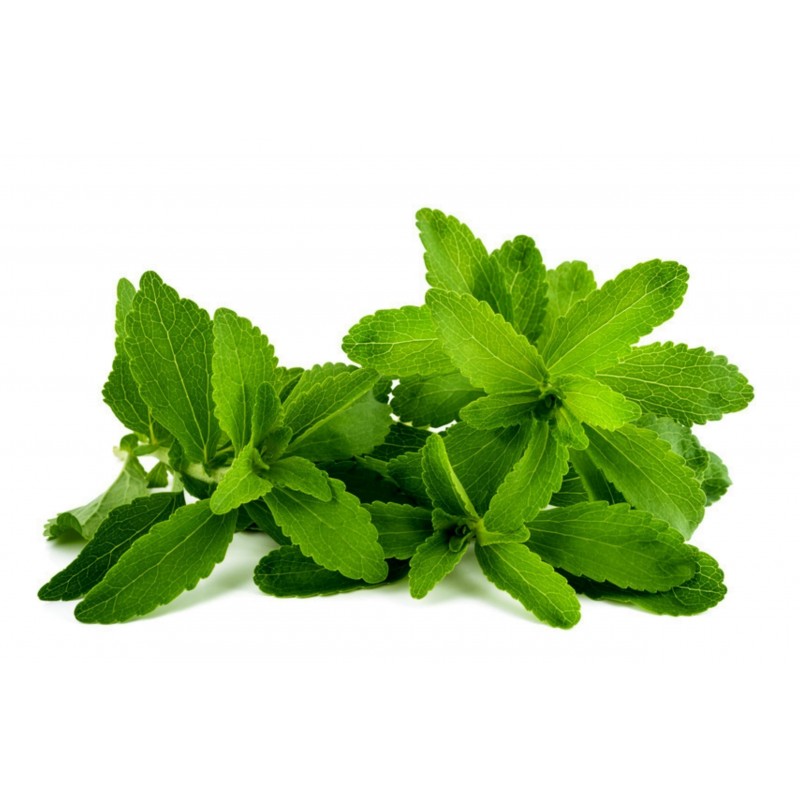
Stevia Seeds (Stevia rebaudiana)
Stevia Seeds - Herb
Price for Package of +-100 (0,06 g) seeds.
Stevia is a genus of about 240 species of herbs and shrubs in the sunflower family (Asteraceae), native to subtropical and tropical regions from western North America to South America. The species Stevia
Stevia Seeds - Herb
Price for Package of +-100 (0,06 g) seeds.
History and use
In 1899, the Swiss botanist Moisés Santiago Bertoni, during his research in eastern Paraguay first described the plant and the sweet taste in detail.[11] Only limited research was conducted on the topic until, in 1931, two French chemists isolated the glycosides that give stevia its sweet taste.[12] These compounds were named stevioside and rebaudioside, and are 250–300 times as sweet as sucrose, heat stable, pH stable, and non-fermentable.
Today, stevia is cultivated and used in food elsewhere in east Asia, including in China (since 1984), Korea, Taiwan, Thailand, and Malaysia. It can also be found in Saint Kitts and Nevis, in parts of South America (Brazil, Colombia, Peru, Paraguay, and Uruguay), and in Israel. China is the world's largest exporter of stevioside.
Folk medicine and research
Sowing Instructions | |
| Propagation: | Seeds |
| Pretreat: | 0 |
| Stratification: | 0 |
| Sowing Time: | all year round |
| Sowing Depth: | Needs Light to germinate! Just sprinkle on the surface of the substrate + gently press |
| Sowing Mix: | Coir or sowing mix + sand or perlite |
| Germination temperature: | min. 21 ° C |
| Location: | bright + keep constantly moist not wet |
| Germination Time: | 1-2 weeks |
| Watering: | Water regularly during the growing season |
|
|
|
| Organic Seeds ? | Organic Seeds |
|---|---|
| Organic/natural ? | Organic/Natural: Yes |
| Edible ? | Edible |
| Perennial ? | Perennial plant : Yes |
| Handgeplukte zaden? | Handgeplukte zaden |
| Plant is suitable for growing ? | The plant is suitable for growing in a greenhouse The plant is suitable for growing on a balcony-terrace The plant is suitable for outdoors cultivation |
| Suitable for growing in flower pot ? | Suitable for pot: Yes |
| Medicinal Plant ? | Medicinal Plant: Yes |
| Seeds requires light for germination ? | Requires light for germination |


Uw beoordelingswaardering kan niet worden verzonden
Rapporteer reactie
Melding verzonden
Uw opmerking kan niet worden verzonden
Schrijf uw recensie
Beoordeling verstuurd
Uw beoordeling kan niet worden verzonden
🌍 Wereldwijde verzending vanuit de EU
Wij versturen wereldwijd vanuit de Europese Unie via aangetekende post met ontvangstbevestiging.
📦 Pakket volgen
Log in op je account en ga naar Bestelhistorie > Details om je track & trace-nummer te vinden.
Wereldwijde tracking: 17Track
Voor nummers zoals RGxxxxxxHR: Posta.hr tracking
🕒 Wacht minimaal 24 uur na verzending voordat trackinginformatie beschikbaar is.
⚠️ Belangrijke informatie
Betalen bij aflevering is niet mogelijk.
Controleer regelmatig je spam- of ongewenste mailfolder voor belangrijke e-mails.
Gebruik uitsluitend het contactformulier op onze website.
Directe e-mails worden mogelijk niet beantwoord.
📱 Telefoonnummer verplicht
Vermeld bij je bestelling altijd je mobiele telefoonnummer inclusief landcode.
Voorbeeld: +31 6 12345678
🚚 Leveringsvoorwaarden
Aangetekende zendingen vereisen een handtekening van de ontvanger.
Bestel niet als:
Je pakket in een brievenbus geleverd moet worden
Je niet thuis bent om het pakket in ontvangst te nemen
Je wilt dat het pakket bij de buurman wordt bezorgd (❌ niet mogelijk)
📬 Als je een brievenbusadres opgeeft en het pakket kwijt raakt, heb je geen recht op terugbetaling.
↩️ Retourzending en opnieuw verzenden
Als een pakket om welke reden dan ook wordt geretourneerd:
Ben je verantwoordelijk voor retourkosten van €2
En de verzendkosten voor het opnieuw verzenden
⏱ Vertragingen en tracking
Als de tracking aangeeft dat het pakket nog bij de verzender is, betekent dit dat het pakket onderweg is.
Neem contact op met je lokale postkantoor met het trackingnummer voor de meest actuele info.
Wij zijn geen postbedrijf en kunnen het pakket niet voor je volgen.
Wij zijn niet verantwoordelijk voor de levertijd.
🔍 Een onderzoek naar verloren pakketten kan pas gestart worden 30 dagen na verzenddatum.
✈️ Verzendopties
| Verzendmethode | Verwerkingstijd | Verzekering | Mogelijke vertraging | Opmerking |
|---|---|---|---|---|
| Standaard | 7–10 werkdagen | ❌ | 7–14 werkdagen | Goedkoopste optie |
| Prioriteit | 1–7 werkdagen | ❌ | 3–10 werkdagen | Prioriteit in verwerking, niet gegarandeerd sneller |
| Verzekerd | 1–7 werkdagen | ✅ | 3–10 werkdagen | Geld terug bij verlies (tot €150) |
🕒 Geschatte levertijd:
Binnen de EU: 3–20 werkdagen
Wereldwijd: 5–30 werkdagen
Voorbeelden levertijden VS: 27, 22, 19, 17, 13 dagen
💳 Betaalmethoden
💶 Bankoverschrijving (SEPA / IBAN / SWIFT-BIC)
Vermeld altijd je bestelnummer in de omschrijving (bijv. SGS-19811702).
Bij het ontbreken van deze referentie kan je bestelling vertraagd worden of geannuleerd.
Bestellingen die niet binnen 7 dagen betaald zijn, worden automatisch geannuleerd.
🅿️ PayPal
We accepteren alleen betalingen in euro’s via PayPal.
Kies tijdens het betaalproces voor de valuta euro.
💳 Betaling met kaart
Betaling verloopt via onze website: Exotic Seeds Store
We accepteren Visa, MasterCard, American Express, Diners Club, UnionPay, JCB, Discover en meer.
💡 De klant draagt eventuele transactiekosten.
Stuur bij voorkeur een betaalbewijs mee voor een snellere verwerking.
📅 Overige informatie
Wij verwerken en versturen geen bestellingen in het weekend (zaterdag en zondag).
Controleer altijd de belangrijke mededelingen op onze website (feestdagen, speciale voorwaarden e.d.).
📫 Let op:
Stuur geen e-mails rechtstreeks naar ons. Gebruik alleen het contactformulier op onze website voor vragen.
Related Products











